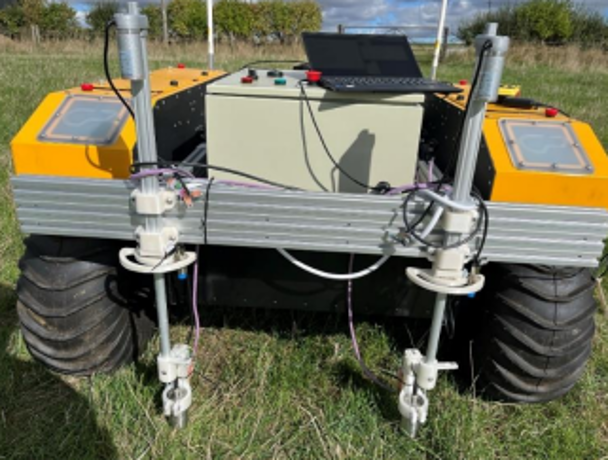|
With support from the STFC Food Network+ (SFN), an interdisciplinary collaboration is breaking new ground in developing low-cost, accurate and autonomous technologies to measure soil properties. “Climate change and soil degradation are twin threats to food security but we can address both at once by improving soil health” says Dr Marcelo Galdos, a soil carbon specialist at Rothamsted Research. “Improving soil carbon levels, for example, boosts productivity and yields by improving nutrient availability and making the system more resilient to climate extremes. At the same time, this can also contribute to bringing down carbon dioxide levels in the atmosphere.”
Our soils are in a perilous state, with a third of global agricultural soils thought to be moderately to highly degraded (FAO). But to restore our soils on a global scale, it is essential that we can quickly and accurately map properties related to soil health in order to understand which regenerative agricultural methods are most effective. A key challenge, however, is that soils vary immensely in terms of their physical, chemical, and biological properties and there is currently no single sensor capable of effectively monitoring all the relevant parameters. In addition, most soil measurement methods are highly time- and labour-intensive, requiring sampling from many different locations in a field. Faced with this situation, Marcelo (then at the University of Leeds) applied for a STFC Food Network+ Scoping Grant to explore potential soil sensing technologies that could be both affordable and automated. This became the Multi-sensor Agricultural Robot for Soils (MARS) project. Bringing down costs The first objective of MARS was to investigate whether the cost and accuracy of soil measurements could be improved by using novel sensors. To do this, Marcelo joined forces with colleagues from the Schools of Computer Science, Electronic and Electrical Engineering, and Food Science at the University of Leeds, and with Dr Patrick Stowell from the School of Physics at the University of Durham. “Patrick provided us with a prototype of an affordable gamma ray sensor that he had designed” says Marcelo. “Professor Megan Povey from the University of Leeds meanwhile is an expert in using ultrasound in food-science applications, such as quality control. This project gave her an opportunity to apply this technology in a completely new area.” The sensors were tested in tandem at the University of Leeds Research Farm site over the 2022 summer, measuring levels of potassium-40 using the gamma ray probe (as a proxy for soil moisture composition) and using the ultrasound probes to assess soil physical properties. “The gamma ray data was able to produce a working map of soil moisture concentration, and we even identified areas in the field with increased water content due to some blocked drainage pits” Marcelo says. “We found, however, that use of the ultrasound sensor would require more research under controlled conditions to calibrate the system.” Going automatic The second component of the project was to assess whether soil monitoring could ultimately become completely automated. “Robotics within UK agriculture is a very exciting sphere at the moment, and many start-ups have already developed promising protypes of automated systems” Marcelo says. But although putting a sensor on a robot sounds simple, this is far from the case, as Marcelo explains: “We had to overcome numerous smaller challenges even before we could start trying to take any measurements. For instance, where should the sensor be installed? How would it be powered? How do we program the robot to move automatically? And how can we capture and record the data?” A particularly difficult problem was developing a mechanism to raise and lower the sensor probe to touch the soil at exactly the right pressure. With support from students in mechanical engineering at the University of Leeds, the team designed and 3D-printed a custom robotic arm that could be mounted on top of the rover. Having equipped the robot with an ultrasound sensor in this way, Dr Syed Zaidi (School of Electronic and Electrical Engineering, University of Leeds) worked with postgraduate students to develop a web interface and self-driving algorithm so that the rover could be automatically programmed to move to a target coordinate and take measurements. The rover was tested in a field on the Leeds Farm, and successfully drove to specific points in the field were measurements would be collected. “Our next step will be to program the rover to take measurements based on covariates including topography, land cover and soil properties” says Marcelo. Future plans Having moved to Rothamsted in July 2023, Marcelo is excited by the prospect of developing this technology further at this centre for excellence in soil science. “Founded in 1843, Rothamsted has some of the longest-running continuous crop experiments in the world” says Marcelo. “This will give us the opportunity to test these technologies on fields for which we have soil data going back over many decades.” Besides developing the prototype rover further, he and his collaborators intend to investigate a range of other potential sensor/robot combinations, for instance integrating drones and satellite data into the analysis. “Funding for feasibility studies such as the SFN Scoping Grants are immensely important for getting innovative ideas off the ground” Marcelo adds. “They allow you to develop a proof of concept to the point that you can attract further investment, besides giving you the freedom to seek out collaborators and build a team. This project ultimately led to me working with experts from a wide range of disciplines, including soil physicists, computer scientists, mechanical engineers, robotics researchers, and specialists in Internet of Things technologies. But this seems highly appropriate, because critical problems such as restoring our global soils will require innovation from many different areas.” Glossary: Gamma spectroscopy: When used in soil sensing applications, gamma spectroscopy measures high-energy photons (gamma rays) that are continuously produced in soils due to the presence of radioactive elements, such as potassium-40. Water in the soil inhibits the flow of gamma rays from the soil to the surface, hence there is an inverse relationship between soil moisture content and the gamma signal recorded above ground.
0 Comments
Your comment will be posted after it is approved.
Leave a Reply. |
AuthorJune 2024 - Archives
June 2024
Categories |
- Home
- Webinars and Events
- About the SFN+
- News
- Blog
- Expert Working Groups
- Funding
-
Publications
- Bioeconomy positioning paper
- SFN+ 5th Annual Conference
- OMM Policy Report
- ‘Multi-Stakeholder International One Day Workshop on Organic Agri-Food Value Chains for Net Zero’ Report
- SFN 2050 UK Net Zero Food report
- Sustainable Cold Food Chain Booklet
- Food Sensing Technologies for Safe and Nutritious Food
- Sustainable urban and vertical farming
- Projects
- Join/Contact Us


 RSS Feed
RSS Feed


